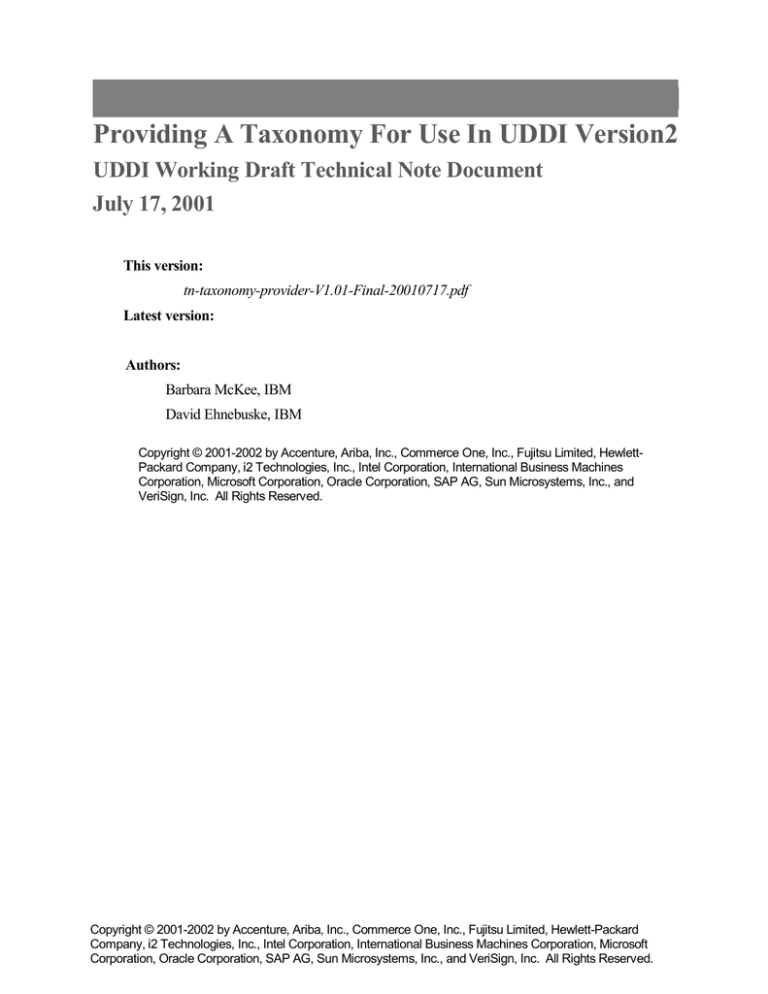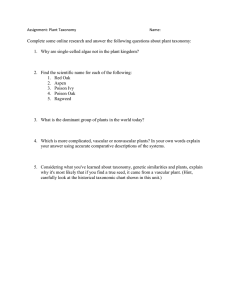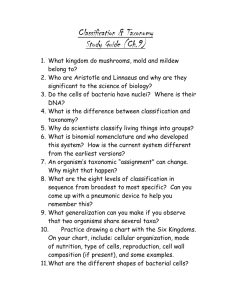
Providing A Taxonomy For Use In UDDI Version2
UDDI Working Draft Technical Note Document
July 17, 2001
This version:
tn-taxonomy-provider-V1.01-Final-20010717.pdf
Latest version:
Authors:
Barbara McKee, IBM
David Ehnebuske, IBM
Copyright © 2001-2002 by Accenture, Ariba, Inc., Commerce One, Inc., Fujitsu Limited, HewlettPackard Company, i2 Technologies, Inc., Intel Corporation, International Business Machines
Corporation, Microsoft Corporation, Oracle Corporation, SAP AG, Sun Microsystems, Inc., and
VeriSign, Inc. All Rights Reserved.
Copyright © 2001-2002 by Accenture, Ariba, Inc., Commerce One, Inc., Fujitsu Limited, Hewlett-Packard
Company, i2 Technologies, Inc., Intel Corporation, International Business Machines Corporation, Microsoft
Corporation, Oracle Corporation, SAP AG, Sun Microsystems, Inc., and VeriSign, Inc. All Rights Reserved.
INTRODUCTION................................................................................................................................................................3
PUBLISHING AN EXTERNAL TAXONOMY................................................................................................................3
To register an unchecked taxonomy................................................................................................................................3
To register a checked taxonomy......................................................................................................................................4
Revocation......................................................................................................................................................................7
PERFORMING VALIDATION.........................................................................................................................................7
REFERENCES.....................................................................................................................................................................8
PAGE 2
Copyright © 2001-2002 by Accenture, Ariba, Inc., Commerce One, Inc., Fujitsu Limited, Hewlett-Packard
Company, i2 Technologies, Inc., Intel Corporation, International Business Machines Corporation, Microsoft
Corporation, Oracle Corporation, SAP AG, Sun Microsystems, Inc., and VeriSign, Inc. All Rights Reserved.
Taxonomies and identifier systems play an important role within UDDI. It is through categorization and
identification that businesses are able to find each other and the services that meet their needs.
Versions 1 and 2 of UDDI cite three common categorization schemes to encourage registrants to
categorize their businesses, services and service descriptions. There are dozens of other taxonomies
available that are newer, gaining in popularity, or targeted at specific constituencies. While UDDI does
not mandate use of these taxonomies, it is imperative that they be made available to those who would
benefit from using them.
A provider of a taxonomy or identifier system can allow unrestricted references to it or may choose to
validate references. Taxonomy and identifier systems that allow unrestricted references are called
unchecked. Conversely, a taxonomy or identifier system that requires references to it to be validated is
called checked. A checked taxonomy or identifier system must have an associated validation service
that performs value checking each time an attempt is made to save data containing a reference to the
taxonomy or identifier system.
This paper guides the providers of taxonomies and identifier systems in the registration of their
taxonomies and through the process of providing a validation service. Since taxonomies and identifier
systems are handled in the same way, for conciseness this paper refers to both as “taxonomies”.
!"!# $&%
The first step in publishing a taxonomy is to decide whether it is to be checked or unchecked because
the process of publishing them is different.
'(*)+-,/. 0213+4)"54687-6-9/:-+-9/;-+-<=1>5-?/(46-(/@BA
To register an unchecked taxonomy you need only publish a tModel for it with a UDDI operator.
Information on registering a tModel can be found in the UDDI Version 2 API Specification. For the
name of your taxonomy, you should specify a urn that reveals its scope, its intent, or both. Use
description to briefly describe what the taxonomy is used for. You may provide the description in
multiple languages. You should make the overviewDoc point to a document describing the details of
the taxonomy, including where to find (or how to compute) valid values and any restrictions on their
use. You should classify the tModel for the taxonomy as being of types categorization and unchecked1
using the uddi-org:types taxonomy. If your tModel is for an unchecked identifier system rather than a
categorization taxonomy, you should use identifier instead of categorization from the uddi-org:types
taxonomy. Once you have published your taxonomy tModel in a UDDI registry it becomes immediately
available for use in that registry. Your unchecked taxonomy tModel would look similar to this one:
<tModel authorizedName="..." operator="..."
tModelKey="uuid:11111111-2222-3333-4444-555555555555">
<name>my-com:partner_types</name>
<description xml:lang="en">
Extendable taxonomy used to categorize my partners.
1
The unchecked and checked categorizations are used to convey the intent of the provider. Neither is used by a UDDI registry to
determine whether a validation service should be invoked to check referenced values or not. Instead, the presence of a validation
service entry for the taxonomy or identifier system in one of the UDDI registry’s Operational Business Entities definitively declares
the taxonomy or identifier system as checked. The absence of an associated validation service entry likewise asserts that the
taxonomy or identifier system as unchecked.
PAGE 3
Copyright © 2001-2002 by Accenture, Ariba, Inc., Commerce One, Inc., Fujitsu Limited, Hewlett-Packard
Company, i2 Technologies, Inc., Intel Corporation, International Business Machines Corporation, Microsoft
Corporation, Oracle Corporation, SAP AG, Sun Microsystems, Inc., and VeriSign, Inc. All Rights Reserved.
</description>
<overviewDoc>
<description xml:lang="en">Initial list of types.
</description>
<overviewURL>
http://www.my.com/partner_types.html
</overviewURL>
</overviewDoc>
<categoryBag>
<keyedReference
tModelKey="uuid:C1ACF26D-9672-4404-9D70-39B756E62AB4"
keyName="uddi-org:types"
keyValue="categorization"/>
<keyedReference
tModelKey="uuid:C1ACF26D-9672-4404-9D70-39B756E62AB4"
keyName="uddi-org:types"
keyValue="unchecked"/>
</categoryBag>
</tModel>
'(*)+-,/. 0213+4)"5=9/:2+49/;-+-<
135-?/(46-(/@BA
Registering a checked taxonomy is a six-step process that involves two parties: you -- the person or
organization providing the taxonomy or identifier system, and the UDDI registry operator with whom
you plan to publish the tModel for the taxonomy – called the custodial operator. The six steps are:
1) You should begin the process by designing the tModel for your taxonomy. This is the same as
what you would do for an unchecked taxonomy (see above) with three exceptions. First, you
should mark the tModel with the checked1 categorization from the uddi-org:types taxonomy
instead of the unchecked. Second, you must also classify the tModel with a categorization of
unvalidatable from the uddi-org:types taxonomy. Marking the tModel unvalidatable prevents
references to any values in the taxonomy or identifier system until every thing is ready to go.
You will remove unvalidatable once the process is complete, making your taxonomy available
for use. Third, you must not publish the tModel. You must instead contact a UDDI registry
operator to do this, as described in the next step.
2) Next, you must choose a UDDI registry operator to act as the custodial operator and contact
that operator, requesting that your tModel be published on your behalf. Once the tModel has
been published, the custodial operator will own (i.e., have the ability to update) the tModel.
Later when the validation service has been activated, the operator will transfer ownership to
you, as described below. You will remove the unvalidatable categorization when you want to
make the taxonomy available for categorization references.
Here is an example of an initial tModel for a checked taxonomy.
<tModel authorizedName="..." operator="..."
tModelKey="uuid:22222222-3333-4444-5555-666666666666">
<name>my-com:realtor_types</name>
<description xml:lang="en">
Fixed taxonomy used to categorize real estate firms.
</description>
<overviewDoc>
<description xml:lang="en">Taxonomy of real estate firm
PAGE 4
Copyright © 2001-2002 by Accenture, Ariba, Inc., Commerce One, Inc., Fujitsu Limited, Hewlett-Packard
Company, i2 Technologies, Inc., Intel Corporation, International Business Machines Corporation, Microsoft
Corporation, Oracle Corporation, SAP AG, Sun Microsystems, Inc., and VeriSign, Inc. All Rights Reserved.
categorizations. Only listed values can be referenced.
Offered only to licensed members of National Board of
Realtors.
</description>
<overviewURL>
http://www.my.com/realtor_types.html
</overviewURL>
</overviewDoc>
<categoryBag>
<keyedReference
tModelKey="uuid:C1ACF26D-9672-4404-9D70-39B756E62AB4"
keyName="uddi-org:types"
keyValue="categorization"/>
<keyedReference
tModelKey="uuid:C1ACF26D-9672-4404-9D70-39B756E62AB4"
keyName="uddi-org:types"
keyValue="checked"/>
<keyedReference
tModelKey="uuid:C1ACF26D-9672-4404-9D70-39B756E62AB4"
keyName="uddi-org:types"
keyValue="unvalidatable"/>
</categoryBag>
</tModel>
3) You must then deploy a validation service for the taxonomy. This service must implement the
validate_values message and return a disposition report indicating success or failure as
described by the uddi-org:taxonomy_V2 tModel. Details about the functions this service is
required to perform can be found in Appendix H of the UDDI Version 2 API Specification.
4) The custodial operator assesses the validation service. While each operator has its own set of
tasks that it performs during the assessment, you can expect some testing of the service to
insure that it performs at an acceptable level. The custodial operator will also require certain
pieces of information to enable it to assess the validation service. These are:
•
Whether caching of valid values is allowed by UDDI registry operators. If caching is
allowed, operators may save data that refers to the taxonomy or identifier systems and
avoid continually calling the validation service if the validation service has previously
checked and okayed the values involved. You should permit caching if you can. Permitting
caching improves the performance of the publishing operation the operator is handling,
and reduces the load on the validation service. You should not permit caching if your
validation service performs contextual examination of the entity being published or if the
operator cache can become invalid.
•
A bindingTemplate for the validation service. The contents of this bindingTemplate will be
used by the custodial operator to set up the actual service binding for your validation
service. Because UDDI registries have performance standards to maintain in calling out
to validation services such as yours, UDDI registry operators require that the accessPoint
URL in the bindingTemplate not be published elsewhere in the same UDDI registry. The
bindingTemplate should reference the uddi-org:taxonomy_V2 tModel, which has the
tModelKey uuid:1E3E9CBC-F8CE-41AB-8F99-88326BAD324A.
PAGE 5
Copyright © 2001-2002 by Accenture, Ariba, Inc., Commerce One, Inc., Fujitsu Limited, Hewlett-Packard
Company, i2 Technologies, Inc., Intel Corporation, International Business Machines Corporation, Microsoft
Corporation, Oracle Corporation, SAP AG, Sun Microsystems, Inc., and VeriSign, Inc. All Rights Reserved.
Here is an example of a binding template for the validation service that is submitted to the
custodial operator:
<bindingTemplate bindingKey="">
<description xml:lang="en">Validation service binding
for my-com:realtor_types
</description>
<accessPoint URLType="http">
http://www.realtor.com/realtor_validation
</accessPoint>
<tModelnstanceDetails>
<tModelnstanceInfo
tModelKey="uuid:22222222-3333-4444-5555-666666666666">
</tModelnstanceInfo>
<tModelnstanceInfo
tModelKey="uuid:1E3E9CBC-F8CE-41AB-8F99-88326BAD324A">
</tModelnstanceInfo>
<tModelnstanceDetails>
</bindingTemplate>
5) The custodial operator registers your validation service in its Operational businessEntity. When
the custodial operator successfully completes the assessment of your validation service, it
publishes a bindingTemplate for the validation service within its own Operational
businessEntity. The bindingTemplate will use a hostingRedirector, as described in Appendix G
of the UDDI Version 2.0 API Specification, instead of the accessPoint you provided to conceal
the actual location of the service. This reduces the risk of denial of service attacks. If at any
time in the future the accessPoint of the validation service changes, you must notify the
custodial operator of the new accessPoint since it is through the operator’s redirected service
binding that the validation service is actually invoked.
What follows is an example of an approved checked taxonomy service binding in a custodial
node operator’s Operational Business Entity:
<businessService businessKey="..." serviceKey="...">
<name>Approved validation services</name>
<description>Set of service bindings for
approved validation services</description>
<bindingTemplates>
<bindingTemplate bindingKey="..." serviceKey="...">
<description xml:lang="en">Validation service binding
for my-com:realtor_types
</description>
<hostingRedirector
bindingKey="... of redirector service binding ...">
</hostingRedirector>
<tModelnstanceDetails>
<tModelnstanceInfo
tModelKey="uuid:22222222-3333-4444-5555-666666666666">
</tModelnstanceInfo>
<tModelnstanceInfo
tModelKey="...tModelKey for uddi-org:taxonomy_V2...">
</tModelnstanceInfo>
<tModelnstanceDetails>
</bindingTemplate>
</bindingTemplates>
PAGE 6
Copyright © 2001-2002 by Accenture, Ariba, Inc., Commerce One, Inc., Fujitsu Limited, Hewlett-Packard
Company, i2 Technologies, Inc., Intel Corporation, International Business Machines Corporation, Microsoft
Corporation, Oracle Corporation, SAP AG, Sun Microsystems, Inc., and VeriSign, Inc. All Rights Reserved.
</businessService>
Once the custodial operator creates the service binding and has set up the hosting redirector, it
will transfer ownership of the tModel to you and notify you that everything is ready to go.
6) You should then remove the unvalidatable categorization from the tModel, thus causing the
taxonomy to become active.
+ (494521 . (/6
If at any time you wish to disable the validation service, you may re-apply the unvalidatable
categorization to the taxonomy’s tModel. Attempts to categorize using the taxonomy will then
fail until the unvalidatable categorization is once again removed. However, existing references
to a taxonomy that has been marked unvalidatable are “grandfathered” such that updates to
the referencing entity will not fail due to the unavailability of the validation service, but new
references will not be able to be validated and will be rejected. Since disabling an existing
taxonomy can be quite inconvenient for its users, you should avoid it when possible.
Each UDDI registry operator has policies for handling validation services that fail to perform acceptably.
These range from making the taxonomy or identifier system temporarily unavailable, to removing the
approved service. If your registered validation service fails to operate acceptably, the custodial
operator will likely contact you to work towards finding a remedy to the problem. First steps will often
include taking the taxonomy or identifier system out of service by adding the unvalidatable
categorization back to the taxonomy’s tModel. When the problem is resolved, the unvalidatable
categorization is again removed. If you cannot get the validation service back on line, the operator can
remove your validation service from its Operational businessEntity. This has the affect of making the
taxonomy or identifier system unchecked. An unchecked taxonomy that is in use cannot be
subsequently converted (back) to a checked taxonomy.
$
The validation service for a checked taxonomy or identifier system is invoked by the registry operator to
validate attempts to publish entities that reference that taxonomy. When an entity being published
contains at least one keyedReference within it that references the tModelKey of the checked taxonomy
or identifier system, the taxonomy’s associated validation service is invoked (unless the values
specified in the entity are cached). The service is passed the entity being published. The validation
service must inspect each relevant keyedReference in the entity for invalid values. The service can
merely check that the values are from an allowed set, or it may perform contextual validation using the
entity information it is passed.
Because UDDI operators call validation services during a publish operation, they are encouraged to
optimize their validation service invocations by calling only once the validation services that share a
common access point. Thus, if a validation service is capable of validating several taxonomies or
identifier systems, and the validation service bindings for each of the taxonomies and identifier systems
have the same access point, the validation service must validate in a single invocation all the
references from all the taxonomies and identifier systems that it knows about in the entity passed.
A validation service must:
1) Check the validity of keyValues in all applicable keyedReferences it is passed.
2) Return the result of the validation in a dispositionReport. If all applicable keyValues are valid,
success is returned in the dispositionReport. If validation fails for any applicable keyValue, an
PAGE 7
Copyright © 2001-2002 by Accenture, Ariba, Inc., Commerce One, Inc., Fujitsu Limited, Hewlett-Packard
Company, i2 Technologies, Inc., Intel Corporation, International Business Machines Corporation, Microsoft
Corporation, Oracle Corporation, SAP AG, Sun Microsystems, Inc., and VeriSign, Inc. All Rights Reserved.
error message explaining why at least one keyValue failed validation should be captured in the
errInfo element content and returned in a disposition report with the E_invalidValue or
E_valueNotAllowed error. The validation service may stop after the first invalid keyValue is
detected, or it may check all of the applicable values.
1. “UDDI Version 2.0 API Specification”, June 2001. Available at http://uddi.org/pubs/ProgrammersAPI-V2.00Open-20010608.doc.
PAGE 8
Copyright © 2001-2002 by Accenture, Ariba, Inc., Commerce One, Inc., Fujitsu Limited, Hewlett-Packard
Company, i2 Technologies, Inc., Intel Corporation, International Business Machines Corporation, Microsoft
Corporation, Oracle Corporation, SAP AG, Sun Microsystems, Inc., and VeriSign, Inc. All Rights Reserved.







